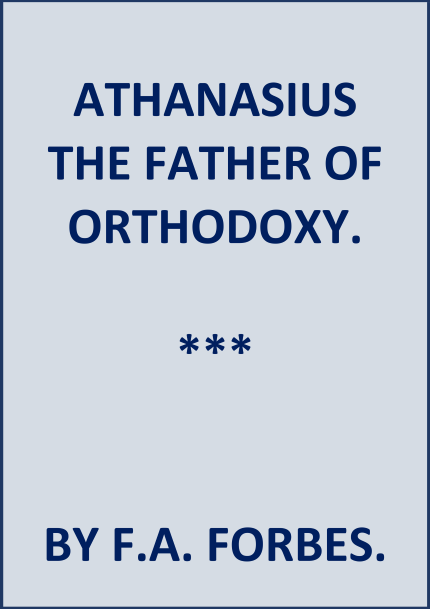By F. A. Forbes.
“Born of the Father before all ages, God of God, Light of Light, true God of true God, begotten not made, consubstantial with the Father . . . ” —From the Nicene Creed

Athanasius, the Father of Orthodoxy.
By F. A. Forbes
About Athanasius
Athanasius I of Alexandria (c. 296–298 – 2 May 373), also called Athanasius the Great, Athanasius the Confessor, or, among Coptic Christians, Athanasius the Apostolic, was a Coptic church father and the 20th pope of Alexandria (as Athanasius I). His intermittent episcopacy spanned 45 years (c. 8 June 328 – 2 May 373), of which over 17 encompassed five exiles, when he was replaced on the order of four different Roman emperors. Athanasius was a Christian theologian, a Church Father, the chief defender of Trinitarianism against Arianism, and a noted Egyptian Christian leader of the fourth century.
Conflict with Arius and Arianism, as well as with successive Roman emperors, shaped Athanasius’ career. In 325, at age 27, Athanasius began his leading role against the Arians as a deacon and assistant to Bishop Alexander of Alexandria during the First Council of Nicaea. Roman Emperor Constantine the Great had convened the council in May–August 325 to address the Arian position that the Son of God, Jesus of Nazareth, is of a distinct substance from the Father. Three years after that council, Athanasius succeeded his mentor as pope of Alexandria. In addition to the conflict with the Arians (including powerful and influential Arian churchmen led by Eusebius of Nicomedia), he struggled against the Emperors Constantine, Constantius II, Julian the Apostate and Valens. He was known as Athanasius Contra Mundum (Latin for ‘Athanasius Against the World’).
Nonetheless, within a few years of his death, Gregory of Nazianzus called him the “Pillar of the Church”. His writings were well regarded by subsequent Church fathers in the West and the East, who noted their devotion to the Word-become-man, pastoral concern and interest in monasticism. Athanasius is considered one of the four great Eastern Doctors of the Church in the Catholic Church. In his Easter letter of 367, Athanasius was the first person to list the 27 books of the New Testament canon that are in use today. He is venerated as a saint in the Eastern Orthodox Church, the Catholic Church, the Coptic Orthodox Church, the Anglican Communion, and Lutheranism.
Frances A. M. Forbes writes that when Patriarch Alexander was on his death-bed he called Athanasius, who fled fearing he would be constrained to be made bishop. “When the Bishops of the Church assembled to elect their new Patriarch, the whole Catholic population surrounded the church, holding up their hands to Heaven and crying; “Give us Athanasius!” The Bishops had nothing better. Athanasius was thus elected, as Gregory tells us…” (Pope Gregory I had full access to the Vatican Archives)
“During the forty-eight years of his episcopate, his history is told in the history of the controversies in which he was constantly engaged with the Arians, and of the sufferings he had to endure in defence of the Nicene faith. We have seen that when Arius was allowed to return from exile in 328, Athanasius refused to remove the sentence of excommunication.”
From WIKIPEDIA
CONTENTS
- A Foreshadowing
- Arius the Heresiarch
- The Great Council
- The Calm Before the Storm
- False Witnesses
- A Royal-Hearted Exile
- The Day of Rejoicing
- The Invisible Patriarch
- A Short-Lived Peace
- The Last Exile
- The Truce of God
Looking for a Hardcover or Paperback?
For those who want to have a hardcover or a paperback of this book, I want to suggest you to look here.